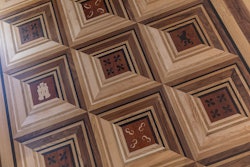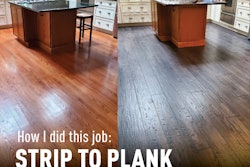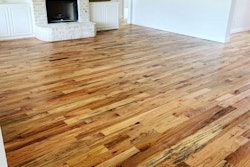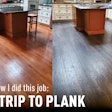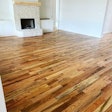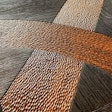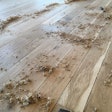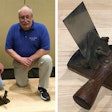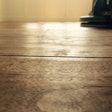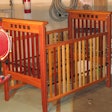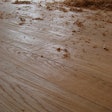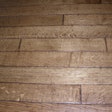Picking up where I left off on the re-scrape of that walnut floor:
Deep down in our innocent young hearts, we all knew that power tools could not replicate the look of true hand-scraping. We thought we’d try anyway. What did we have to lose, right? As I realized there was no way around hand-scraping that floor inch by inch, I made a plan:
• Controlled speed of scraping—no starting fast and burning out after two hours (one of my guys was like that on the first day and quickly realized his mistake). Keep the pace for the whole day.
• Have enough blades on site. Those knots in the walnut floor really damage a hook blade. I am not a fan of hooking my blades. I buy them ready to go. Sorry, no patience here.
• Have more than enough snacks, water, sugary drinks and music.
• Rotate the guys around so that the scrape pattern is well mixed up throughout the floor.
• Most importantly, focus and be consistent.
• Most importantly, number 2: have fun!
I found that scraping the knots with a regular scraper first really helped speed up the process...
That’s about it. Scraping a floor is a hard therapeutic task. That is the way I see it. It is just me kneeling on the floor shaping and scraping that beautiful wood. No noise from power tools, no running back and forth to get more tools, no worrying about sanding sequence, scratch pattern or perfection. Scraping is all about working with the wood. If you know how to read the wood you will get the most out of it. If you know what a knot is, interlocking grain and (in general) the basic parts of the wood you’ll better work it with your scraper. For example, if you scrape one way and you get chatter or your scraper skips and tears the grain, you might try to scrape the other way. That’s how you know in which direction the grain goes. Another example is interlocking grain—no matter which direction you scrape, the wood chatters and tears. Then you want to go at an angle, like a big machine on a new floor.
I found that scraping the knots with a regular scraper first really helped speed up the process and saved my hook blades from bending or chipping.
I classify my job sites at rough, medium and fine stages. On this job the “rough” was when we initially scraped the floor, the “medium” was when we swept and crawled the floor to re-scrape any no-so-great looking areas, chatter or missed areas. The “fine” stage was when we vacuumed and hand sanded the floor. Yes, hand-sanded. What? Well, what do you mean by that? For all of you young guys and girls out there with a power tool for every task (that would be me, too), and for those who’d rather drive around the block for two hours looking for a parking spot instead of walking (that would be me, too) hand-sanding is when you use your HANDS to sand the floor. We first ran the buffer on the floor with a maroon pad to smooth out the rough spots. Then we vacuumed and crawled the floor with a scraper in one hand to touch up any fine details and 120-grit in the other. We sanded with the grain and made sure we got into all the low spots in the floor. Then we vacuumed one more time and ran the maroon pad again on the buffer to clean up our knee pad marks, scuffs and such.
That is it. The floor was now ready for oil, or as I refer to it, wax on, wax off. Next time I will walk you through the steps of oiling a hand-scraped floor.
Be cool.















